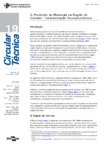Please use this identifier to cite or link to this item:
http://www.infoteca.cnptia.embrapa.br/infoteca/handle/doc/567392Full metadata record
| DC Field | Value | Language |
|---|---|---|
| dc.contributor.author | AGUIAR, J. L. P. de | pt_BR |
| dc.contributor.author | SPERRY, S. | pt_BR |
| dc.contributor.author | JUNQUEIRA, N. T. V. | pt_BR |
| dc.date.accessioned | 2011-07-08T11:40:36Z | - |
| dc.date.available | 2011-07-08T11:40:36Z | - |
| dc.date.created | 2003-12-09 | pt_BR |
| dc.date.issued | 2001 | pt_BR |
| dc.identifier.citation | Planaltina, DF: Embrapa Cerrados, 2001. | pt_BR |
| dc.identifier.uri | http://www.infoteca.cnptia.embrapa.br/infoteca/handle/doc/567392 | pt_BR |
| dc.description | ABSTRACT: In the thirteen years, Brazil has produced about 353 thousands tons/year of passion fruit and processed 123.55 thousands/year. The per capita consumption was 1.5 kg/person/year of fresh fuit and 0.33 kg/person/year as juice and pulp. Additionally, it can be emphasized that the production in the fruit market as sourness passion fruit in Brazilian Savannahs in the year 2000, reached 50.5 thousand tons/year, from which 35% was destined to industry. This study was conducted as field research interview, carried out in the 1998/2000 period, considering a sample of 11% of a population, composed by passion fruit producers, technical assistance personnel, nursery producers, and industry managers, involving twelve production municipalities. Additionally, they were obtained some secondary data related to the passion fruit production chain. Considering the importance of this crop production for the investigated region, this work was established aiming to analyze the crop production system, including its relationship with the market, in order to identify and characterize the main agents that affect the commercialization process. Beside this, it was intended to raise important information in order to establish, at least a partial view, on the passion fruit production chain. It was observed that the economical sustainability of passion fruits in the area, especially in the segment of commercialization of fresh fruits, depends on several actions: definition of an adequate crop system, including provision for seeds with good genetic quality; development of new varieties, more resistant do diseases and with satisfactory degree of adaptation to local climatic conditions; implementation of an efficient program for pest control and soil-water plant nutrition; establishment of an adequate system for controlling the quality and the sanitary aspects of young plants and seeds; financial support to improve farming system organization and to increase crop productivity; and technical assitance to improve farmers managing capability. | pt_BR |
| dc.language.iso | por | pt_BR |
| dc.relation.ispartofseries | (Embrapa Cerrados. Circular Técnica, 19). | pt_BR |
| dc.rights | openAccess | pt_BR |
| dc.subject | Socioeconomia | pt_BR |
| dc.subject | Socioeconomic | pt_BR |
| dc.subject | Production | pt_BR |
| dc.subject | Comercialization | pt_BR |
| dc.title | A produção de maracujá na região do cerrado: caracterização socioeconômica. | pt_BR |
| dc.type | Folhetos | pt_BR |
| dc.date.updated | 2011-07-08T11:40:36Z | pt_BR |
| dc.subject.thesagro | Agronegócio | pt_BR |
| dc.subject.thesagro | Comercialização | pt_BR |
| dc.subject.thesagro | Maracujá | pt_BR |
| dc.subject.thesagro | Passiflora Edulis | pt_BR |
| dc.subject.thesagro | Produção | pt_BR |
| dc.subject.thesagro | Sistema de Produção | pt_BR |
| dc.subject.nalthesaurus | agribusiness | pt_BR |
| dc.subject.nalthesaurus | farming systems | pt_BR |
| dc.subject.nalthesaurus | passion fruits | pt_BR |
| dc.format.extent2 | 30 p. | pt_BR |
| riaa.ainfo.id | 567392 | pt_BR |
| riaa.ainfo.lastupdate | 2009-10-28 | pt_BR |
| Appears in Collections: | Circular Técnica (CPAC)  | |
Files in This Item:
| File | Description | Size | Format | |
|---|---|---|---|---|
| cirtec19.pdf | 541.4 kB | Adobe PDF |  View/Open |









